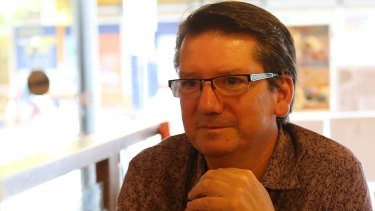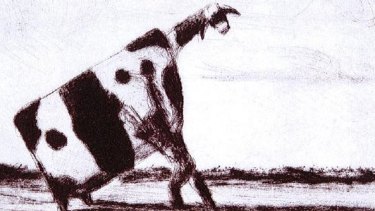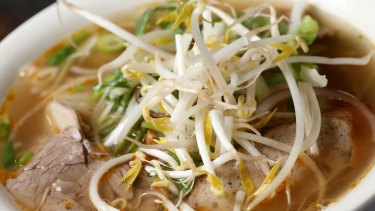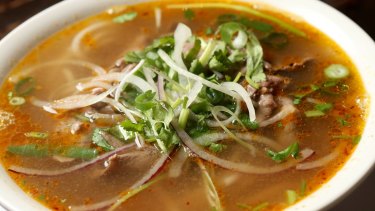Cow Up a Tree Drawing
- Culture
- Art & design
This was published 6 years ago
Cow-up-a-tree-artist John Kelly - Australia's most famous artist you never knew
By Kylie Northover
Australian artist John Kelly loves his home in Cork, Ireland, where he and his family have lived for the past 12 years, but there's one thing he misses: Vietnamese food. We meet at Co Do, (arguably) the best Vietnamese restaurant in Sunshine, where Kelly grew up, and where his parents still live, to talk about Kelly's newest artwork.
The only living artist to be represented by Sotheby's, he's perhaps best-known for his massive sculptures Two Men lifting A Cow and Pile of Cows, and the now-permanent Cow Up A Tree in Docklands. These monumental sculptures, constructed from up to five tonnes of bronze, have been exhibited in Paris, Ireland and the Hague, and a handful of them reside in private collections. And his next one, Man Lifting Cow, will be unveiled next year – in downtown Sunshine.

Artist John Kelly has lunch with Age journalist Kylie Northover at CoDo. Credit:Pat Scala
On his last trip home, Kelly's mum had cut out an article from the local paper calling for submissions for a new sculptural work to be placed outside Sunshine's new civic centre, currently under construction.
"It had closed the day before but I started a dialogue with Brimbank Council," he says. "They didn't know that I'd grown up in Sunshine and … I said I'd like to leave something as a kind of legacy of having grown up here."

Man Lifting Cow sketch by artist John Kelly, who grew up in Sunshine.
Kelly's cows are known as 'Dobell's cows', a reference to one of Australian art's more curious stories that has long intrigued him. In the 1940s, Australian painter William Dobell, along with other artists, was hired as a "camouflage artist" to disguise local airfields to deceive Japanese air force planes; they made sheds look like Chinese market gardens, painting rows of cabbages on aircraft hangars. Then there's the famous story that Dobell, who went on to win the Archibald prize, was charged with creating giant papier mache cows. There's little historical evidence that these cows existed, but it's become a great fable of Australian modernist art history – and an inspiration for Kelly.
The camouflage artists and their work had little bearing on the war, but Kelly was attracted to the project's mix of seriousness and absurdity.
"There's only one literary reference in an obituary written in Reader's Digest, by Dobell's surgeon – and there's a lot of doubt as to whether they even existed. But to me that's not important because the work is not about cows; it's about the idea of these artists trying to camouflage things. Art is never really about ... what it's about," he says. "It was a great thing to launch off as a painter."
Over prawn rice paper rolls and spring rolls, Kelly explains that his first series of paintings were about cricket, after a stint playing district cricket. It was when he was studying fine art back in Australia that he first read about Dobell and the camouflage artists.

The chilli beef soup at CoDo in Sunshine. Credit:Pat Scala
After the cows, which garnered him global recognition, came Kelly's audacious "logo" series, a critique of the "branding of the arts" and Australia's arts bureaucracy in the Howard government years.
After accepting an invitation in 2002 to exhibit work in the Monte Carlo International Sculpture Festival, Kelly was subsequently sued by a Parisian art dealer who claimed to be his agent in France.

CoDo's sliced rare beef with chilli beef soup Credit:Pat Scala
"I received the invitation from a dealer who I didn't want to work with, so I said no," explains Kelly, adding that his London gallery wanted him to do it if the invitation was passed through them. He accepted and began the long, expensive process of creating a sculpture, only to find the French dealer had decided to sue him.
"So I went into this project having to raise the funds to build the thing – hundreds of thousands of dollars – and also fight a legal battle, which eventually ran for five years!"
It was "serious stuff", with the dealer asking for a million Euro in compensation. Kelly sought support from the Australia Council for the Arts and the Australian embassy; the embassy refused his request for mediation but the Australia Council offered a small grant.
"In my naivete I approached them [and] asked for some support – they put me through a process that was utterly ridiculous – and in the end, after I'd applied, on their advice, for $10,000, they offered me $5000 – for a work that would cost hundreds of thousands!"
Kelly appealed, which took a further 10 months, during which time he found himself questioning the institution and in particular its hiring of advertising agency Saatchi and Saatchi, at great cost, to prepare a report for the body, Australians and the Arts, the key finding of which was that the arts were "a brand". It was an idea that Kelly found disturbing: it was, he says "anti-art".
When he discovered he was contractually obliged to use the Australia Council's logo if he accepted their grant, it was too late to put it in the catalogue for the festival but he told them he would "acknowledge them in future exhibitions".
His "acknowledgements" have formed the basis for several series now, in which Kelly uses the elements of the Australia Council's sun and kangaroo, which the arts body insist must "never be altered or separated". He's subverted their logo across several series and media, even creating a label for MONA art gallery founder David Walsh's Moo Brew Beer in 2005, using the motifs.
In a way, his logo series continues further his exploration of camouflage, or concealed reality; like the mythical papier mache cows, these works reflects the sophistry he encountered with the arts bureaucracy.
Kelly has brought me a four-pack of David Walsh's craft beer, but he doesn't drink ("I gave up four years ago; I'm too obsessional so it's easier to just not do it at all," he says, adding that he plans to take it back up at 75). I order a coconut juice and he has an iced tea with our main course – we've both opted for Co Do's specialty (from an incredible 200-plus dishes), the Hue traditional Vietnamese-style chilli beef soup, with sliced beef, pork, beef loaf, pork hock, prawn cake and blood. Luckily we've both ordered the small, which is enormous, and comes with all the accompaniments – a bargain at just $8.50. "It's supposed to be the best soup of its kind in Melbourne," Kelly tells me.
David Walsh has been a long-time supporter of his work, he says over slurps of soup.
"I met him 2004 or 2005 – he was a very shy collector, didn't like publicity at all," he says.
Kelly attributes some of his early fame to Walsh, after the collector bought his stack of cows (Kelly won't reveal how much they cost but aside from the one in Docklands owned by the City of Melbourne, he keeps one on his property in Ireland, another is owned by a man who owns an oil company, and another by "the 80th wealthiest man in the world".)
After his Three Cows In A Pile went on something of a tour in the UK, including a trip to the 2007 Glastonbury Festival, the British indie band the Kaiser Chiefs even featured one of them in their video for the song Heat Dies Down.
Walsh initially wanted Kelly to use cows on his Moo Brew beer (because, well, cows) but when Kelly told him about his Australia Council-inspired work, he "took about 30 seconds to say yes". "That's how I went from cows to branding; I thought it was a lovely progression," says Kelly.
The logo project, though, hasn't endeared him to many in the local arts bureaucracy; even as recently as at this year's Venice Biennale he says people from the Australia Council "literally turned their backs on me". "It did come at a cost, but at the same time, doing the series stopped me from becoming bitter and twisted," he says.
In 2013, he was accepted for an Australian Antarctic Arts Fellowship, where he spent more than a month as artist-in-residence. An exhibition in Tasmania – which is currently travelling – and a book followed; and he's recently exhibited landscape works in New York. Right now though, Kelly is thrilled to be working on his Man Lifting Cow.
"It's a really important work for me, for a number of reasons," he says.
One of those reasons, in an echo of his mum snipping out the Brimbank Council's sculpture ad in the local paper, is the way he got his start as an artist: his parents couldn't afford to send him to college but in 1983, his mum had entered – and won – a competition called "Win a Wish" on the back of a milk carton. Her wish was to send her son to art school.
"It relates to the Dobell's cows of course but can also be read in other ways; the man lifting the cow is in overalls, and my great memory of my father was always in overalls, when he worked at the quarry. And there's the allusion to milk, so to both my parents," he says.
With his parents in their 80s, and recalling "no art or cultural touch points" in Sunshine when he was growing up, Kelly is thrilled to be able to leave some kind of legacy in his hometown.
"I can foresee in a few years I won't really have a reason to come back," he says. "And this sculpture is imbued with very personal meaning."
John Kelly's Man Lifting Cow is expected to be completed and installed in Hampshire Road, Sunshine, in late 2016.
Most Viewed in Culture
Loading
Source: https://www.smh.com.au/entertainment/art-and-design/cowupatreeartist-john-kelly--australias-most-famous-artist-you-never-knew-20151211-glld0e.html
0 Response to "Cow Up a Tree Drawing"
Post a Comment